

The Ages of Exploration
Cook’s voyages map.
Quick Facts:
The map shows the three voyages of Captain James Cook. The first voyage is in red, the second voyage is in green and the third voyage is in blue. Following Cook’s death, the route his crew took is in the blue dashed line. (Credit: Andre Engels)

- The Mariners' Educational Programs
- Bibliography
James Cook and his voyages
The son of a farm labourer, James Cook (1728–1779) was born at Marton in Yorkshire. In 1747 he was apprenticed to James Walker, a shipowner and master mariner of Whitby, and for several years sailed in colliers in the North Sea, English Channel, Irish Sea and Baltic Sea. In 1755 he volunteered for service in the Royal Navy and was appointed an able seaman on HMS Eagle . Within two years he was promoted to the rank of master and in 1758 he sailed to North America on HMS Pembroke . His surveys of the St Lawrence River, in the weeks before the capture of Quebec, established his reputation as an outstanding surveyor. In 1763 the Admiralty gave him the task of surveying the coast of Newfoundland and southern Labrador. He spent four years on HMS Grenville , recording harbours and headlands, shoals and rocks, and also observed an eclipse of the sun in 1766.
First voyage
In May 1768 Cook was promoted to the rank of lieutenant and given command of the bark Endeavour . He was instructed to sail to Tahiti to observe the transit of Venus in 1769 and also to ascertain whether a continent existed in the southern latitudes of the Pacific Ocean. The expedition, which included a party of scientists and artists led by Joseph Banks, left Plymouth in August 1768 and sailed to Brazil and around Cape Horn, reaching Tahiti in April 1769. After the astronomical observations were completed, Cook sailed south to 40°S, but failed to find any land. He then headed for New Zealand, which he circumnavigated, establishing that there were two principal islands. From New Zealand he sailed to New Holland, which he first sighted in April 1770. He charted the eastern coast, naming prominent landmarks and collecting many botanical specimens at Botany Bay. The expedition nearly ended in disaster when the Endeavour struck the Great Barrier Reef, but it was eventually dislodged and was careened and repaired at Endeavour River. From there it sailed around Cape York through Torres Strait to Batavia, in the Dutch East Indies. In Batavia and on the last leg of the voyage one-third of the crew died of malaria and dysentery. Cook and the other survivors finally reached England in July 1771.
Second voyage
In 1772 Cook, who had been promoted to the rank of captain, led a new expedition to settle once and for all the speculative existence of the Great Southern Continent by ‘prosecuting your discoveries as near to the South Pole as possible’. The sloops Resolution and Adventure , the latter commanded by Tobias Furneaux, left Sheerness in June 1772 and sailed to Cape Town. The ships became separated in the southern Indian Ocean and the Adventure sailed along the southern and eastern coasts of Van Diemen’s Land before reuniting with the Resolution at Queen Charlotte Sound in New Zealand. The ships explored the Society and Friendly Islands before they again became separated in October 1773. The Adventure sailed to New Zealand, where 10 of the crew were killed by Maori, and returned to England in June 1774. The Resolution sailed south from New Zealand, crossing the Antarctic Circle and reaching 71°10’S, further south than any ship had been before. It then traversed the southern Pacific Ocean, visiting Easter Island, Tahiti, the Friendly Islands, New Hebrides, New Caledonia, Norfolk Island and New Zealand. In November 1774 Cook began the homeward voyage, sailing to Chile, Patagonia, Tierra del Fuego, South Georgia and Cape Town. The expedition reached England in July 1775.
Third voyage
A year later Cook left Plymouth on an expedition to search for the North West Passage. His two ships were HMS Resolution and Discovery , the latter commanded by Charles Clerke. They sailed to Cape Town, Kerguelen Island in the southern Indian Ocean, Adventure Bay in Van Diemen’s Land, and Queen Charlotte Sound in New Zealand. They then revisited the Friendly and Society Islands. Sailing northwards, Cook became the first European to travel to the Hawaiian Islands (which he named the Sandwich Islands), and reached the North American coast in March 1778. The ships followed the coast northwards to Alaska and the Bering Strait and reached 70°44’N, before being driven back by ice. They returned to the Sandwich Islands and on 14 February 1779 Cook was killed by Hawaiians at Kealakekua Bay. Clerke took over the command and in the summer of 1779 the expedition again tried unsuccessfully to penetrate the pack ice beyond Bering Strait. Clerke died in August 1779 and John Gore and James King commanded the ships on the voyage home via Macao and Cape Town. They reached London in October 1780.
Acquisition
The earliest acquisitions by the Library of original works concerning Cook’s voyages were the papers of Sir Joseph Banks and a painting of John Webber, which were acquired from E.A. Petherick in 1909. In 1923 the Australian Government purchased at a Sotheby’s sale in London the Endeavour journal of James Cook, together with four other Cook documents that had been in the possession of the Bolckow family in Yorkshire. The manuscripts of Alexander Home were purchased from the Museum Bookstore in London in 1925, while the journal of James Burney was received with the Ferguson Collection in 1970. A facsimile copy of the journal of the Resolution in 1772–75 was presented by Queen Elizabeth II in 1954.
The 18 crayon drawings of South Sea Islanders by William Hodges were presented to the Library by the British Admiralty in 1939. They had previously been in the possession of Greenwich Hospital. The view from Point Venus by Hodges was bought at a Christie’s sale in 1979. The paintings of William Ellis were part of the Nan Kivell Collection, with the exception of the view of Adventure Bay, which was bought from Hordern House in Sydney in 1993. The painting of the death of Cook by George Carter and most of the paintings of John Webber were also acquired from Rex Nan Kivell. The painting by John Mortimer was bequeathed to the Library by Dame Merlyn Myer and was received in 1987.
Description
Manuscripts.
The Endeavour journal of James Cook (MS 1) is the most famous item in the Library’s collections. It has been the centrepiece of many exhibitions ever since its acquisition in 1923, and in 2001 it became the first Australian item to be included on the United Nations Educational, Scientific and Cultural Organization’s (UNESCO’s) Memory of the World Register. While there are other journals of the first voyage that are partly in Cook’s hand, MS 1 is the only journal that is entirely written by Cook and covers the whole voyage of the Endeavour . The early entries in 1768, as the ship crossed the Atlantic Ocean, are brief but the passages describing Cook’s experiences and impressions in Tahiti, New Zealand and New South Wales in 1769–70 are very detailed. The journal, which is 753 pages in length, was originally a series of paper volumes and loose sheets, but they were bound into a single volume in the late nineteenth century. The current binding of oak and pigskin dates from 1976.
Two other manuscripts, also acquired in 1923, relate to the first voyage. The Endeavour letterbook (MS 2), in the hand of Cook’s clerk, Richard Orton, contains copies of Cook’s correspondence with the Admiralty and the various branches of the Navy Board. Of particular importance are the original and additional secret instructions that he received from the Lords of the Admiralty in July 1768. The other item (MS 3) is a log of the voyage, ending with the arrival in Batavia. The writer is not known, although it may have been Charles Green, the astronomer. Other documents concerning the voyage are among the papers of Joseph Banks (MS 9), including his letters to the Viceroy of Brazil in 1768 and the ‘Hints’ of the Earl of Morton, the president of the Royal Society.
The Library holds a facsimile copy (MS 1153) of the journal of HMS Resolution on the second voyage, the original of which is in the National Maritime Museum in London. It is in the hand of Cook’s clerk, William Dawson. It also holds the journal (MS 3244) of James Burney, a midshipman on HMS Adventure , covering the first part of the voyage in 1772–73. It includes a map of eastern Van Diemen’s Land and Burney’s transcription of Tongan music. In addition, there is a letterbook (MS 6) of the Resolution for both the second and third voyages. Documents of the third voyage include an account of the death of Cook (MS 8), probably dictated by Burney, and two manuscripts of Alexander Home (MS 690). They contain descriptions of Tahiti and Kamtschatka and another account of Cook’s death.
The earliest manuscript of Cook in the collection is his description of the coast of Nova Scotia, with two maps of Harbour Grace and Carbonere, dating from 1762 (MS 5). The Library holds original letters of Cook written to John Harrison, George Perry, Sir Philip Stephens and the Commissioners of Victualling. There is also in the Nan Kivell Collection a group of papers and letters of the Cook family, 1776–1926 (MS 4263).
MS 1 Journal of the H.M.S. Endeavour, 1768-1771
MS 2 Cook's voyage 1768-71 : copies of correspondence, etc. 1768-1771
MS 3 Log of H.M.S. Endeavour, 1768-1770
MS 5 Description of the sea coast of Nova Scotia, 1762
MS 6 Letterbook, 1771-1778
MS 8 Account of the death of James Cook, 1779
MS 9 Papers of Sir Joseph Banks, 1745-1923
MS 690 Home, Alexander, Journals, 1777-1779
MS 1153 Journal of H.M.S. Resolution, 1772-1775
MS 3244 Burney, James, Journal, 1772-1773
MS 4263 Family papers 1776-1926
Many records relating to the voyages of Cook have been microfilmed at the National Archives (formerly the Public Record Office) in London and other archives and libraries in Britain. They include the official log of HMS Endeavour and the private journals kept by Cook on his second and third voyages. The reels with the prefixes PRO or M were filmed by the Australian Joint Copying Project.
mfm PRO 3268 Letters of Capt. James Cook to the Admiralty, 1768–79 (Adm. 1/1609-12)
mfm PRO 1550–51 Captain’s log books, HMS Adventure , 1772–74 (Adm. 51/4521-24)
mfm PRO 1554 Captain’s log books, HMS Discovery , 1776–79 (Adm. 51/ 4528-9)
mfm PRO 1554 Captain’s log books, HMS Resolution , 1779 (Adm. 51/4529)
mfm PRO 1555–6 Captain’s log books, HMS Discovery , 1776–79 (Adm. 51/4530-1)
mfm PRO 1561–3 Captain’s log books, HMS Endeavour , 1768–71 (Adm. 51/4545-8)
mfm PRO 1565–70 Captain’s log books, HMS Resolution , 1771–79 (Adm. 51/4553-61)
mfm PRO 1572 Logbooks, HMS Adventure , 1772–74 (Adm. 53/1)
mfm PRO 1575–6 Logbooks, HMS Discovery , 1776–79 (Adm. 53/20-24)
mfm PRO 1580 Logbooks, HMS Endeavour , 1768–71 (Adm. 53/39-41)
mfm PRO 1590–4 Logbooks, HMS Resolution , 1771–80 (Adm. 53/103-24)
mfm PRO 1756 Logbook, HMS Adventure , 1772–74 (BL 44)
mfm PRO 1756 Observations made on board HMS Adventure , 1772–74 (BL 45)
mfm PRO 1756A Logbook, HMS Resolution , 1772–75 (BL 46)
mfm PRO 1756 Observations made on board HMS Resolution , 1772–75 (BL 47)
mfm PRO 1756 Journal of Capt. J. Cook: observations on variations in compass and chronometer rates, 1776 (BL 48)
mfm PRO 1756 Astronomical observations, HMS Resolution , 1778–80 (BL 49)
mfm PRO 4461–2 Ship’s musters, HMS Endeavour , 1768–71 (Adm. 12/8569)
mfm PRO 4462–3 Ship’s musters, HMS Adventure , 1769–74 (Adm. 12/7550)
mfm PRO 4463–4 Ship’s musters, HMS Resolution , 1771–75 (Adm. 12/7672)
mfm PRO 4464 Ship’s musters, HMS Discovery , 1776–80 (Adm. 12/8013)
mfm PRO 4464–5 Ship’s musters, HMS Resolution , 1776–80 (Adm. 12/9048-9)
mfm PRO 6119 Deptford Yard letterbooks, 1765-78 (Adm. 106/3315-8)
MAP mfm M 406 Charts and tracings of Australian and New Zealand coastlines by R. Pickersgill and Capt. James Cook, 1769–70 (Hydrographic Department)
mfm M 869 Letters of David Samwell, 1773–82 (Liverpool City Libraries)
mfm M 1561 Log of HMS Endeavour , 1768–71 (British Library)
mfm M 1562 Journal of Capt. Tobias Furneaux on HMS Adventure , 1772–74 (British Library)
mfm M1563 Drawings of William Hodges on voyage of HMS Resolution , 1772–74 (British Library)
mfm M 1564 Log of Lieut. Charles Clerke on HMS Resolution , 1772–75 (British Library)
mfm M 1565 Journal of Lieut. James Burney on HMS Discovery , 1776–79 (British Library)
mfm M 1566 Journal of Thomas Edgar on HMS Discovery , 1776–79
mfm M 1580 Journal of Capt. James Cook on HMS Resolution , 1771–74 (British Library)
mfm M 1580–1 Journal of Capt. James Cook on HMS Resolution , 1776–79 (British Library)
mfm M 1583 Journal of David Samwell on HMS Resolution and Discovery , 1776–79 (British Library)
mfm M 2662 Correspondence of Sir Joseph Banks, 1768–1819 (Natural History Museum)
mfm M 3038 Letters of Capt. James Cook, 1775–77 (National Maritime Museum)
mfm M 3074 Drafts of Capt. James Cook’s account of his second voyage (National Maritime Museum)
mfm G 9 Journal of voyage of HMS Endeavour , 1768–71 (National Maritime Museum)
mfm G 13 Journal of voyage of HMS Resolution , 1772–75 (National Maritime Museum)
mfm G 27412 Journal of Capt. James Cook on HMS Endeavour , 1768–70 (Mitchell Library)
The only manuscript maps drawn by Cook held in the Library are the two maps of Halifax Harbour, Nova Scotia, contained in MS 5. The map by James Burney of Van Diemen’s Land, contained in his 1773–74 journal, is the only manuscript map in the Library emanating from Cook’s three Pacific voyages.
On the first voyage most of the surveys were carried out by Cook himself, assisted by Robert Molyneux, the master, and Richard Pickersgill, the master’s mate. Cook produced some of the fair charts, but it seems that most were drawn by Isaac Smith, one of the midshipmen. After the voyage the larger charts were engraved by William Whitchurch and a number of engravers worked on the smaller maps. The Library holds nine maps (six sheets) and five coastal views (one sheet) published in 1773, as well as two French maps of New Zealand and New South Wales based on Cook’s discoveries (1774).
Cook and Pickersgill, who had been promoted to lieutenant, carried out most of the surveys on the second voyage. Others were performed by Joseph Gilbert, master of the Resolution , Peter Fannin, master of the Adventure , the astronomer William Wales and James Burney. Isaac Smith, the master’s mate, again drew most of the fair charts of the voyage and William Whitchurch again did most of the engravings. The Library holds 15 maps (10 sheets) published in 1777.
On the third voyage, Cook seems to have produced very few charts. Most of the surveys were carried out by William Bligh, master of the Resolution , and Thomas Edgar, master of the Discovery . Henry Roberts, the master’s mate and a competent artist, made the fair charts and after the voyage he drew the compilation charts from which the engraved plates were produced. Alexander Dalrymple supervised the engravings. The Library holds five maps and five coastal views published in 1784–86.
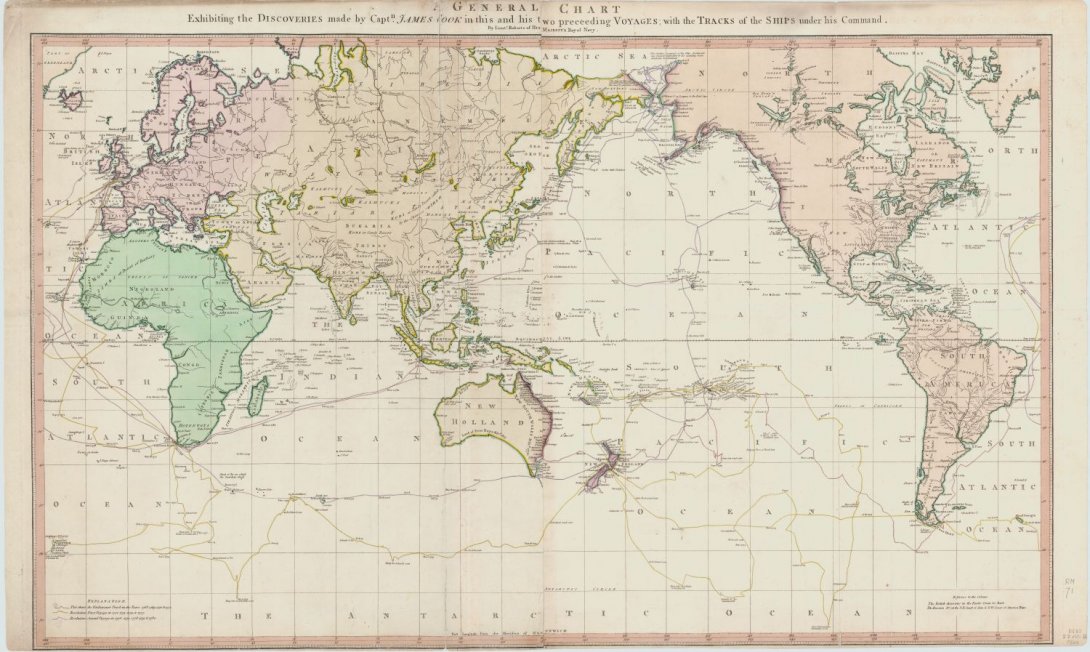
The Library holds a number of objects that allegedly belonged to Cook, such as a walking stick, a clothes brush and a fork. A more substantial artefact is a mahogany and rosewood fall-front desk that was believed to have been used by Cook on one of his voyages. Other association items are a compass, protractor, ruler and spirit level owned by Alexander Hood, the master’s mate on HMS Resolution in 1772–75.
Three of the medals issued by the Royal Society in 1784 to commemorate the achievements of Cook are held in the Library. Another medal issued in 1823 to commemorate his voyages is also held.
The Library has several collections of tapa cloth, including a piece of cloth and two reed maps brought back by Alexander Hood in 1774 and a catalogue of 56 specimens of cloth collected on Cook’s three voyages (1787).
Captain James Cook's walking stick
Clothes brush said to have been the property of Captain Cook
Captain James Cook's fork
Mahogany fall-front bureau believed to have been used by Captain Cook
Compass, protractor, ruler and spirit level owned by Alexander Hood
Commemorative medal to celebrate the voyages of Captain James Cook (1784)
Medal to commemorate the voyages of Captain Cook (1823)
Sample of tapa cloth and two reed mats brought back by Alex Hood
A catalogue of the different specimens of cloth collected in the three voyages of Captain Cook
The Library holds a very large number of engraved portraits of James Cook, many of them based on the paintings by Nathaniel Dance, William Hodges and John Webber. It also holds two oil portraits by unknown artists, one being a copy of the portrait by Dance held in the National Maritime Museum in London. Of special interest is a large oil painting by John Mortimer, possibly painted in 1771, depicting Daniel Solander, Joseph Banks, James Cook, John Hawkesworth and Lord Sandwich.
There were two artists on the Endeavour : Alexander Buchan, who died in Tahiti in 1769, and Sydney Parkinson, who died in Batavia in 1771. The Library has a few original works that have been attributed to Parkinson, in particular a watercolour of breadfruit, which is in the Nan Kivell Collection. In addition, there are a number of prints that were reproduced in the publications of Hawkesworth and Parkinson in 1773, including the interior of a Tahitian house, the fort at Point Venus, a view of Matavai Bay, Maori warriors and war canoes, mountainous country on the west coast of New Zealand, and a view of Endeavour River.
William Hodges was the artist on the Resolution in 1772–75. The Library holds an outstanding collection of 18 chalk drawings by Hodges of the heads of Pacific Islanders. They depict men and women of New Zealand, Tahiti, Tonga, New Caledonia, New Hebrides and Easter Island. Other works by Hodges include an oil painting of a dodo and a red parakeet, watercolours of Tahiti, Tonga and the New Hebrides, and an oil painting of Point Venus. There are also two pen and wash drawings of the Resolution by John Elliott, who was a midshipman on the ship. Among the prints of Hodges are other heads of Pacific Islanders, a portrait of Omai, the Tahitian who visited England in 1775–76, and views of Tahiti, New Caledonia, New Hebrides, Norfolk Island, Easter Island and Tierra del Fuego.
John Webber, who was on the Resolution in 1776–80, had been trained as a landscape artist in Berne and Paris. Another artist on the expedition was William Ellis, the surgeon’s mate on the Discovery , who was a fine draughtsman. The Library holds 19 of Webber’s watercolours, ink and wash drawings, crayon drawings and pencil drawings of views in Tahiti, the Friendly Islands, the Sandwich Islands, Alaska and Kamchatka. There are also oil portraits by Webber of John Gore and James King. Ellis is equally well represented, with 23 watercolours, ink drawings and pencil drawings of scenes in Kerguelen Island, New Zealand, Tahiti, Nootka Sound, Alaska and Kamchatka. Of particular interest is a watercolour and ink drawing by Ellis of the Resolution and Discovery moored in Adventure Bay in 1777, the earliest original Australian work in the Pictures Collection. The death of Cook is the subject of the largest oil painting in the Library’s collection, painted by George Carter in 1781.
Omai, the first Polynesian to be seen in London, was the subject of a number of portraits, included a celebrated painting by Sir Joshua Reynolds. The Library has a pencil drawing of Omai by Reynolds. A pantomime by John O’Keefe entitled Omai, or a Trip Round the World , enjoyed great success in London in 1785–86, being played more than 50 times. The Library holds a collection of 17 watercolour costume designs for the pantomime, drawn by Philippe de Loutherbourg and based mainly on drawings by Webber. The subjects include ‘Obereyaee enchatress’, ‘Otoo King of Otaheite’, ‘a chief of Tchutzki’ and ‘a Kamtchadale’.
Publications
Bibliography.
Beddie,M.K. (ed.), Bibliography of Captain James Cook, R,N., F.R.S., circumnavigator , Library of New South Wales, Sydney, 1970.
Original Accounts of the Voyages
Hawkesworth, John, An account of the voyages undertaken by the order of His Present Majesty, for making discoveries in the Southern Hemisphere, and successively performed by Commodore Byron, Captain Wallis, Captain Carteret, and Captain Cook, in the Dolphin, the Swallow, and the Endeavour (3 vols, 1773)
Parkinson, Sydney, A journal of the voyage to the South Seas, in His Majesty’s Ship, the Endeavour (1773)
Marra, John, Journal of the Resolution’s Voyage, in 1772, 1773, 1774, and 1775, on Discovery to the Southern Hemisphere (1775)
Cook, James, A voyage towards the South Pole, and round the world: performed in His Majesty’s Ships the Resolution and the Adventure in the years 1772,1773, 1774, and 1775 (2 vols, 1777)
Forster, Georg, A voyage round the world in His Britannic Majesty’s Sloop, Resolution, Commanded by Capt. James Cook, during the years 1772, 3, 4 and 5 (2 vols, 1777)
Wales, William, The original astronomical observations, made in the course of a voyage towards the South Pole, and round the world (1777)
Rickman, John, Journal of Captain Cook’s last voyage to the Pacific Ocean, on discovery: performed in the years 1776, 1777, 1778, and 1779 (1781)
Zimmermann, Heinrich, Heinrich Zimmermanns von Wissloch in der Pfalz, Reise um die Welt, mit Capitain Cook (1781)
Ellis, William, An authentic narrative of a voyage performed by Captain Cook and Captain Clerke, in His Majesty’s ships Resolution and Discovery during the years 1776, 1777, 1778, 1779, and 1780 (2 vols, 1782)
Ledyard, John, Journal of Captain Cook’s last voyage to the Pacific Ocean, and in quest of a North-West Passage Between Asia & America, performed in the years 1776, 1777, 1778 and 1779 (1783)
Cook, James and King, James, A voyage to the Pacific Ocean: undertaken by Command of His Majesty, for making discoveries in the Northern Hemisphere, performed under the direction of Captains Cook, Clerke, and Gore, in the years 1776, 1777, 1778, 1779, and 1780 (4 vols, 1784)
Sparrman, Anders, Reise nach dem Vorgebirge der guten Hoffnung, den sudlischen Polarlandern und um die Welt (1784)
Modern Texts
Beaglehole, J.C. (ed.), The Endeavour journal of Joseph Banks, 1768–1771 (2 vols, 1962)
Beaglehole, J.C. (ed.), The journals of Captain James Cook on his voyages of discovery (4 vols, 1955–74)
David, Andrew (ed.), The charts & coastal Views of Captain Cook’s voyages (3 vols, 1988–97)
Hooper, Beverley (ed.), With Captain James Cook in the Antarctic and Pacific: the private journal of James Burney, Second Lieutenant on the Adventure on Cook’s second voyage, 1772–1773 (1975)
Joppien, Rudiger and Smith, Bernard, The art of Captain Cook’s voyages (3 vols in 4, 1985–87)
Parkin, Ray, H.M. Bark Endeavour: her place in Australian history: with an account of her construction, crew and equipment and a narrative of her voyage on the East Coast of New Holland in 1770 (1997)
Biographical Works and Related Studies
There are a huge number of books and pamphlets on the lives of Cook, Banks and their associates. The following are some of the more substantial works:
Alexander, Michael, Omai, noble savage (1977)
Beaglehole, J.C., The life of Captain James Cook (1974)
Besant, Walter, Captain Cook (1890)
Blainey, Geoffrey, Sea of dangers: Captain Cook and his rivals (2008)
Cameron, Hector, Sir Joseph Banks, K.B., P.R.S.: the autocrat of the philosophers (1952)
Carr, D.J., Sydney Parkinson, artist of Cook’s Endeavour voyage (1983)
Carter, Harold B., Sir Joseph Banks, 1743–1820 (1988)
Collingridge, Vanessa, Captain Cook: obsession and betrayal in the New World (2002)
Connaughton, Richard, Omai, the Prince who never was (2005)
Dugard, Martin, Farther than any man: the rise and fall of Captain James Cook (2001)
Duyker, Edward, Nature’s argonaut: Daniel Solander 1733–1782: naturalist and voyager with Cook and Banks (1998)
Furneaux, Rupert, Tobias Furneaux, circumnavigator (1960)
Gascoigne, John, Captain Cook: voyager between worlds (2007)
Hoare, Michael E., The tactless philosopher: Johann Reinhold Forster (1729–98) (1976)
Hough, Richard, Captain James Cook: a biography (1994)
Kippis, Andrew, The life of Captain James Cook (1788)
Kitson, Arthur, Captain James Cook, RN, FRS, the circumnavigator (1907)
Lyte, Charles, Sir Joseph Banks: 18th Century explorer, botanist and entrepreneur (1980)
McAleer, John and Rigby, Nigel, Captain Cook and the Pacific: art, exploration & empire (2017)
McCormick, E.H., Omai: Pacific envoy (1977)
McLynn, Frank, Captain Cook: master of the seas (2011)
Molony, John N., Captain James Cook: claiming the Great South Land (2016)
Moore, Peter, Endeavour: the ship and the attitude that changed the world (2018)
Mundle, Rob, Cook (2013)
Nugent, Maria, Captain Cook was here (2009)
Obeyesekere, Gananath, The apotheosis of Captain Cook: European mythmaking in the Pacific (1992)
O’Brian, Patrick, Joseph Banks, a life (1987)
Rienits, Rex and Rienits, Thea, The voyages of Captain Cook , 1968)
Robson, John, Captain Cook's war and peace: the Royal Navy years 1755-1768 (2009)
Sahlins, Marshall, How ‘natives’ think: about Captain Cook, for example (1995)
Saine, Thomas P., Georg Forster (1972)
Smith, Edward, The life of Sir Joseph Banks, president of the Royal Society (1911)
Thomas, Nicholas, Cook: The extraordinary voyages of Captain James Cook (2003)
Villiers, Alan, Captain Cook, the seamen’s seaman: a study of the great discoverer (1967).
Organisation
The manuscripts of Cook and his associates are held in the Manuscripts Collection at various locations. They have been catalogued individually. Some of them have been microfilmed, such as the Endeavour journal (mfm G27412), the Endeavour log and letterbook (mfm G3921) and the Resolution letterbook (mfm G3758). The Endeavour journal and letterbook and the papers of Sir Joseph Banks have been digitised and are accessible on the Library’s website. The microfilms have also been catalogued individually and are accessible in the Newspaper and Microcopy Reading Room.
The paintings, drawings, prints and objects are held in the Pictures Collection, while the maps and published coastal views are held in the Maps Collection. They have been catalogued individually and many of them have been digitised.
Biskup, Peter, Captain Cook’s Endeavour Journal and Australian Libraries: A Study in Institutional One-upmanship , Australian Academic and Research Libraries , vol. 18 (3), September 1987, pp. 137–49.
Cook & Omai: The Cult of the South Seas , National Library of Australia, Canberra, 2001.
Dening, Greg, MS 1 Cook, J. Holograph Journal , in Cochrane, Peter (ed.), Remarkable Occurrences: The National Library of Australia’s First 100 Years 1901–2001 , National Library of Australia, Canberra, 2001.
Healy, Annette, The Endeavour Journal 1768–71 , National Library of Australia, Canberra, 1997.
Healy, Annette, ' Charting the voyager of the Endeavour journal ', National Library of Australia News, volume 7(3), December 1996, pp 9-12
Hetherington, Michelle, 'John Hamilton Mortimer and the discovery of Captain Cook', British Art Journal, volume 4 (1), 2003, pp. 69-77
First posted 2008 (revised 2019)
The National Library of Australia acknowledges Australia’s First Nations Peoples – the First Australians – as the Traditional Owners and Custodians of this land and gives respect to the Elders – past and present – and through them to all Australian Aboriginal and Torres Strait Islander people.
Cultural Notification
Australian Aboriginal and Torres Strait Islander people are advised that this website contains a range of material which may be considered culturally sensitive including the records of people who have passed away.
Voyages of discovery - the Great South Land
- Gallery of maps
- The Spanish Quest
- The Tasman Map
- The Huijdecoper journal
- Monsters of the southern world
- The case for a Great Southern Continent
- Criticising the Endeavour voyage
- Against the 'thief colony'
- Hydrographic Office
- Dalrymple's Charts
- Coastal views
- Voyage round the world
- James Cook's log
- Cook's discoveries on the map
- Joseph Banks' Endeavour Journal
- James Roberts' journal
- Endeavour artist Sydney Parkinson
- New South Wales on the map
- Discoveries in the Pacific
- Mapping the route
- Images of Cook's second expedition
- Wales & Bayly, astronomers
- Method for preserving health
- James Burney journal
- A Narrative of the death
- James King journal
- Cook's mementos
- Navigational instruments
- Arithmetic for sailors
- Discover more
Captain James Cook's voyages of discovery
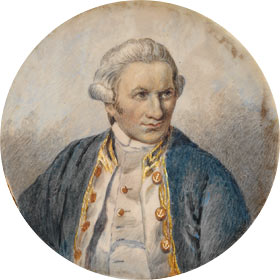
Captain James Cook, ca. 1780-1784 Watercolour on ivory miniature MIN 85
Captain James Cook (1728-1779) was born in Yorkshire. At the age of about 17, Cook joined the merchant navy in the coastal town of Whitby and spent his apprenticeship and early career working on trading ships along the English coast and in the Baltic. After 10 years in the merchant navy, Cook entered the Royal Navy, and showed an aptitude for surveying, mapping and navigation. He honed these skills in military conflicts against France but his talents had been noticed by the Royal Society, which was keen to send British ships to the Pacific for research and exploration purposes.
Captain James Cook's three epic voyages to the South Seas, between 1768-1779, transformed the way Europeans viewed the Great South Land and the Pacific Ocean.
James Cook's first Pacific voyage (1768-1771) was aboard the Endeavour and began on 27 May 1768. Cook's first goal was to establish an observatory at Tahiti to record the transit of Venus, when that planet passed between the earth and the sun, on 3 June 1769. The second aim of the expedition was to record natural history, led by 25-year-old Joseph Banks. The final secret goal was to continue the search for the Great South Land.
> Find out more about James Cook and Joseph Banks and their discovery of New South Wales in Endeavour in 1770

The continued search for the legendary Great South Land also motivated Cook's second Pacific voyage (1772-1775). This voyage aimed to establish whether there was an inhabited southern continent in what we now know as Antarctica, as well as making astronomical observations.
> Find out more about Cook’s second Pacific voyage

Cook's third and final Pacific voyage, (1776-1779), was as important for exploration of the North Pacific as the earlier two had been for the South. The voyage aimed to find a north west passage between the Atlantic and Pacific Oceans. In the process, Cook made the major discovery of the Hawaiian Islands in January 1778. During the same voyage Cook was killed on a return visit to Hawaii at Kealakekua Bay, on 14 February 1779.
> Find out about the death of the Captain Cook in Hawaii during his third voyage of exploration

Quick Links

Discover More
Explore more resources ›
Cook's First Voyage
First voyage of captain james cook.
(1768 - 1771)
James Cook’s first voyage circumnavigated the globe in the ship Endeavour , giving the botanists Joseph Banks and Daniel Solander the opportunity to collect plants from previously unexplored habitats. Although the Endeavour voyage was officially a journey to Tahiti to observe the 1769 transit of Venus across the sun, it also had a more clandestine mission from the Royal Society to explore the South Pacific in the name of England. The two botanists on the expedition returned with a collection of plant specimens including an estimated 100 new families and 1,000 new species of plants, many of which are currently housed in the U. S. National Herbarium.
Joseph Banks, who would later become Sir Joseph Banks and president of the Royal Society, was a wealthy young scientist. He invited his close friend Daniel Solander, a Swedish student of Linnaeus working in the natural history collections of the British Museum, to join him on the Endeavour expedition. Together they acted as the naturalists on the voyage, commanding several servants and artists, including Sydney Parkinson, and outfitted with an excellent array of scientific equipment. After setting out from London, the expedition stopped briefly at Madeira, a small Portuguese island in the Atlantic Ocean, and then continued on to Rio de Janiero, on the eastern coast of Brazil. Here, the expedition encountered one of its first major setbacks when the Portuguese governor Dom Antonio Rolim de Moura Tavare refused to allow anyone from the Endeavour to come on land except to acquire necessities. This restriction, however, didn’t stop the two determined botanists. Banks and Solander risked being arrested as spies or smugglers in order to sneak onshore to collect specimens around the city. Despite this difficulty, the expedition traveled on to Tierra del Fuego at the southern tip of South America, where they collected a large number of specimens despite bitterly cold weather that killed two members of the crew. In April of 1769, the expedition reached Tahiti, where they stayed until July. During this time, Banks and Solander collected over 250 plant species, including the orchids Liparis revoluta and Oberonia equitans (also known as Oberonia disticha ) and the flowering plant Ophiorrhiza solandri , in the first extensive botanical study in Polynesia.
After viewing the transit of Venus on June 3, 1769, the expedition began mapping, exploring, and collecting specimens in the relatively unknown regions of New Zealand and the eastern coast of Australia (then called New Holland). Plants collected included the large orchid Dendrobium cunninghamii , also known as Winika cunninghamii , native to the western shore of New Zealand, as well as white-honeysuckle ( Banksia integrifolia ), native to the east coast of Australia. The Endeavour stopped for nine days at a bay on the coast of Australia, where, according to Banks, the expedition’s plant collection became “so immensely large that it was necessary that some extraordinary care should be taken of them least they should spoil.” The botanists were so successful that Cook decided to name the place Botany Bay in honor of their extensive discoveries.
The Endeavour continued its voyage mapping the eastern coast of Australia, narrowly avoiding shipwreck on the Great Barrier Reef, until it re-entered known waters near New Guinea in late August, 1770. During the last part of the voyage, the Endeavour stopped at the disease-ridden city of Batavia in Java and at the Cape of Good Hope in Africa, returning to England in July, 1771. Overall, the expedition was very successful, with little strife among the crew and no deaths from scurvy. Although neither Banks nor Solander published their botanical findings, the two naturalists returned to England with a vast wealth of new discoveries.
References:
Adams, Brian. The Flowering of the Pacific . Sydney: William Collins Pty, 1986. Allen, Oliver E. The Pacific Navigators . Canada: Time-Life Books, 1980. Global Biodiversity Information Facility (GBIF) database, http://gbif.org/ (for information on plant species Dendrobium cunninghamii ; accessed June 15, 2010). Ebes, Hank. The Florilegium of Captain Cook’s First Voyage to Australia: 1768-1771 . Melbourne: Ebes Douwma Antique Prints and Maps, 1988. Encyclopedia of Life (EOL) database, http://www.eol.org/ (for information on plant species Oberonia disticha and Dendrobium cunninghamii ; accessed June 15, 2010). Merrill, Elmer Drew. The Botany of Cook’s Voyages and its Unexpected Significance in Relation to Anthropology, Biogeography and History . Waltham, Massachusetts: Chronica Botanica Co., 1954. O’Brian, Patrick. Joseph Banks: A Life . Boston: David R. Gardine, Publisher, 1993. Rauchenberg, Roy A. “Daniel Carl Solander: Naturalist on the ‘Endeavour’,” Transactions of the American Philosophical Society , New Series, 58, no. 8 (1968): 1-66. http://www.jstor.org/stable/1006027 (May 26, 2010). National Library of Australia. “South Seas: Voyaging and Cross-Cultural Encounters in the Pacific.” South Seas , n.d. http://southseas.nla.gov.au/ . Contains maps and text of expedition journals by James Cook and Joseph Banks. USDA PLANTS database. United States Department of Agriculture, Natural Resources Conservation Service. National Plant Data Center. http://plants.usda.gov/ (for information on plant species Banksia integrifolia ; accessed June 15, 2010).
- Smithsonian Institution
- Terms of Use
- Privacy Policy
- Host an Event
British navigator James Cook charted New Zealand and Australia's Great Barrier Reef on his ship HMB Endeavour and later disproved the existence of the fabled southern continent Terra Australis.
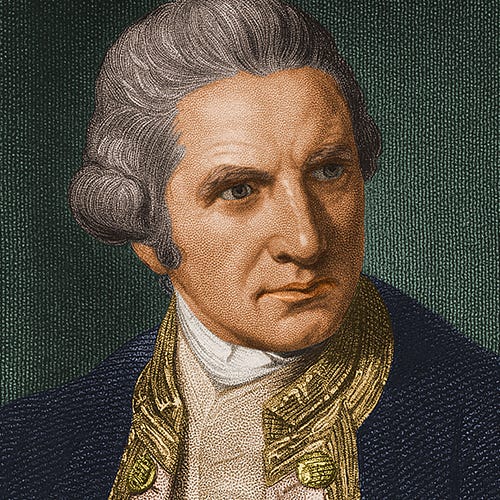
(1728-1779)
Who Was James Cook?
James Cook was a naval captain, navigator and explorer who, in 1770, charted New Zealand and the Great Barrier Reef of Australia on his ship HMB Endeavour. He later disproved the existence of Terra Australis, a fabled southern continent. Cook's voyages helped guide generations of explorers and provided the first accurate map of the Pacific.
Early Life and Career
Cook was born in Marton-in-Cleveland, Yorkshire, England, on October 27, 1728, the son of a Scottish farmhand. As a teenager, Cook did farming work alongside his father until the age of 18 when he was offered an apprenticeship by a Quaker shipowner in a small seaside village near Whitby, England. The experience proved to be fortuitous for the future naval officer and explorer, bringing him in contact with both the ocean and ships along the port.
Naval Officer, Navigator and Explorer
Cook eventually joined the British Navy and, at age 29, was promoted to ship's master. During the Seven Years War (1756-1763), he commanded a captured ship for the Royal Navy. In 1768, he took command of the first scientific expedition to the Pacific. In 1770, on his ship the HMB Endeavour, Cook charted New Zealand and the Great Barrier Reef of Australia. This area has since been credited as one of the world's most dangerous areas to navigate.
After his return to England, Cook was chosen to circumnavigate and explore Antarctica. On this voyage, he charted present-day Tonga, Easter Island, New Caledonia, the South Sandwich Islands and South Georgia, and disproved the existence of Terra Australis, a fabled southern continent. Cook named the Hawaiian Islands the Sandwich Islands after the Earl of Sandwich, also known as John Montagu.

Later Years, Death and Legacy
During all his voyages, Cook successfully fought scurvy, a deadly disease caused by vitamin deficiency, by feeding his crew a diet that included watercress, sauerkraut and orange extract. He died in a skirmish with islanders during a winter layover in Kealakekua Bay, Hawaii, on February 14, 1779.
Today, Cook's voyages are credited with helping to guide generations of explorers and with providing the first accurate map of the Pacific, and many believe that he did more to fill the map of the world than any other explorer in history.
QUICK FACTS
- Name: James Cook
- Birth Year: 1728
- Birth date: October 27, 1728
- Birth City: Marton-in-Cleveland, Yorkshire, England
- Birth Country: United Kingdom
- Gender: Male
- Best Known For: British navigator James Cook charted New Zealand and Australia's Great Barrier Reef on his ship HMB Endeavour and later disproved the existence of the fabled southern continent Terra Australis.
- War and Militaries
- Astrological Sign: Scorpio
- Death Year: 1779
- Death date: February 14, 1779
- Death State: Hawaii
- Death City: Kealakekua Bay
- Death Country: United States
We strive for accuracy and fairness. If you see something that doesn't look right, contact us !

Famous British People

Alan Cumming

Olivia Colman
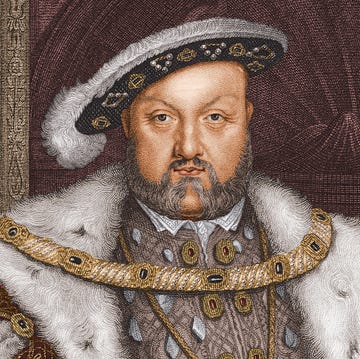
Richard III
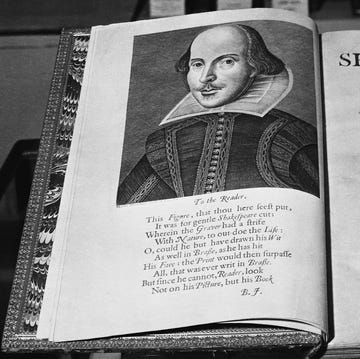
20 Shakespeare Quotes

William Shakespeare

Andy Murray

Stephen Hawking

Gordon Ramsay

Kiefer Sutherland

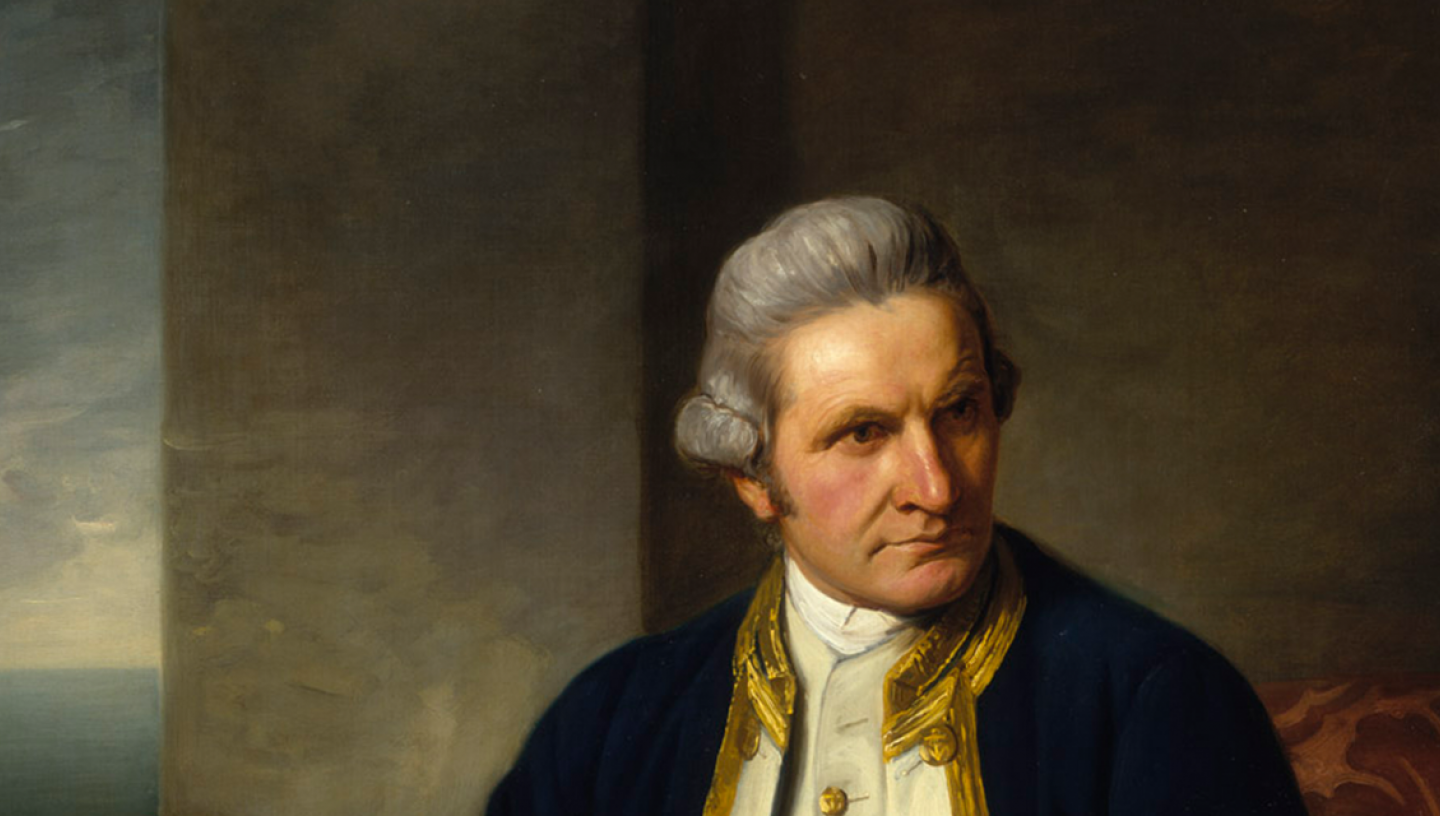
Captain James Cook timeline
Follow the key events in Captain Cook’s life of adventure from a simple start to global fame and a grisly death.
Captain Cook rose from humble beginnings in Yorkshire to become a national hero. To his contemporaries in the Navy he was renowned for his precise surveying, innovations in keeping his crew healthy and early championing of Harrison’s solution to the problem of longitude.
- 1728: Born in Marton in Yorkshire.
- 1746: Accepted as a sea apprentice by John Walker, head of a shipping firm engaged in the East Coast coal trade.
- 1755: Volunteers for the Royal Navy.
- July 1757: Promoted master of the Solebay, later the Pembroke .
- 1763–1766: Surveys the coast of Newfoundland, observes an eclipse.
- Summer 1768: Sails for Tahiti on HMS Endeavour to record observations of the Transit of Venus.
- June 1769: Opens secret instructions from the Admiralty – he is to sail south in search for Terra Australis Incognita and explore the coast of New Zealand.
- Autumn 1769: Sails around New Zealand, expertly charting the coast and proving that it is not part of a great southern continent.
- Spring 1770: Lands in Botany Bay encountering the first aborigines.
- October 1770: The Endeavour lands at Batavia for a much-needed refit. Many of Cook's men suffer and die from malaria and dysentery.
- July 1772: Cook, now a commander, sets out with two colliers, Resolution and Adventure.
- January 1773: Cook becomes the first navigator to cross the Antarctic Circle.
- Summer 1773: The crews return to Tahiti and then visit Tonga. When they turn south to explore the Antarctic once more, the two vessels lose touch and Furneaux, in command of Adventure , leaves New Zealand and heads home.
- January 1774: Cook's travels in the South Pacific have proved that there is no habitable continent. Instead of returning home, he continues to explore.
- Spring 1774: Cook explores and accurately charts Easter Island, the Marquesas Islands and the Friendly Isles and others.
- November 1774: Resolution heads for home.
- Summer 1776: Cook sets off again with the Resolution and Discovery in search of the North-West passage.
- December 1776: After a spell at Tahiti, Cook sets out for the Sandwich Islands (named in honour of the First Lord of the Admiralty, the Earl of Sandwich).
- Summer 1778: The two ships head north, charting the southern coast of Alaska. An impenetrable ice wall forces them back to Hawaii. Initially, Cook is greeted as a god but relations between the sailors and the islanders soon deteriorate.
- February 1779: Cook and his men depart but are forced back two days later when the Resolution springs her foremast. Relations are again strained and after a series of thefts Cook goes ashore. He is attacked, overpowered and stabbed to death.
- 1779–October 1780: Clerke, previously in charge of the Discovery , now takes command but dies of consumption six months later. Lieutenant Gore of the Resolution eventually brings the ships home.
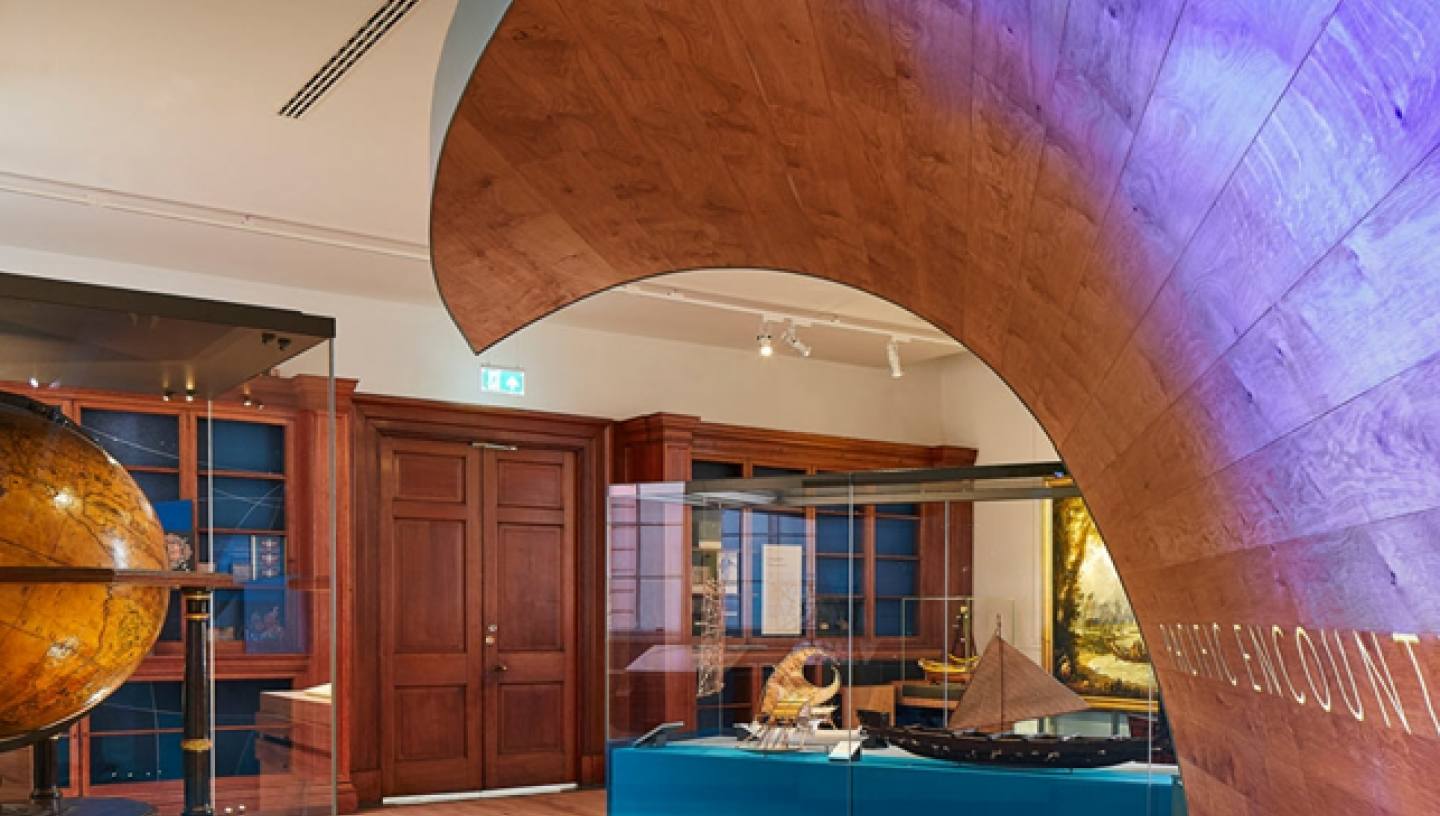
Pacific Encounters
Voyages of James Cook

- 1.2 Royal Navy and First Voyage
- 1.3 Second Voyage
- 1.4 Third Voyage
- 2.1 England
- 2.2 Australia
- 2.3 New Zealand
<a href=\"https://tools.wmflabs.org/wikivoyage/w/poi2gpx.php?print=gpx&lang=en&name=Voyages_of_James_Cook\" title=\"Download GPX file for this article\" data-parsoid=\"{}\"><img alt=\"Download GPX file for this article\" resource=\"./File:GPX_Document_rev3-20x20.png\" src=\"//upload.wikimedia.org/wikipedia/commons/f/f7/GPX_Document_rev3-20x20.png\" decoding=\"async\" data-file-width=\"20\" data-file-height=\"20\" data-file-type=\"bitmap\" height=\"20\" width=\"20\" class=\"mw-file-element\" data-parsoid='{\"a\":{\"resource\":\"./File:GPX_Document_rev3-20x20.png\",\"height\":\"20\",\"width\":\"20\"},\"sa\":{\"resource\":\"File:GPX Document rev3-20x20.png\"}}'/></a></span>"}'/>

Captain James Cook was a British explorer, navigator, cartographer, and captain in the Royal Navy. Sailing both eastwards and westwards around the world, Cook and his crews explored parts of the world no European had sailed before, and like Magellan 258 years earlier, his life ended in a battle on the shores of the Pacific.

Born in 1728 in the village of Marton in North Yorkshire, when he was 16 (1745) Cook moved to the fishing village of Staithes, to be apprenticed as a shop boy. After 18 months, not proving suited for shop work, Cook travelled to the nearby port town of Whitby and was introduced to John and Henry Walker, who were Quakers, and prominent local ship-owners in the coal trade. Their house is now the Captain Cook Memorial Museum. Cook was taken on as a merchant navy apprentice in their small fleet of vessels, plying coal along the English coast. His first assignment was aboard the collier Freelove , and he spent several years on this and various other coasters, sailing between the Tyne and London . As part of his apprenticeship, Cook applied himself to the study of algebra, geometry, trigonometry, navigation and astronomy—all skills he would need one day to command his own ship.
Royal Navy and First Voyage
He joined the Royal Navy in 1755, and saw action in the Seven Years' War (1756 - 1763), surveying and mapping much of the entrance to the Saint Lawrence River during the siege of Quebec City , which fell to the British on 13 September 1759. This brought him to the attention of the Admiralty and Royal Society, which led to his commission in 1766 as commander of HM Bark Endeavour for a scientific expedition, his first voyage (1768–1771) to the Pacific Ocean, to observe and record the 1769 transit of Venus across the Sun from Tahiti . This data, when combined with observations from other places, would help to determine the distance of the Earth from the Sun. Cook, at age 39, was promoted to lieutenant to grant him sufficient status to take the command. For its part, the Royal Society agreed that Cook would receive a one hundred guinea gratuity (£105) in addition to his Naval pay.
The expedition departed England on 26 August 1768, rounded Cape Horn and continued westward across the Pacific, arriving at Tahiti on 13 April 1769, where the observations of the Venus Transit were made, proving not as conclusive or accurate as had been hoped. Once these were completed, Cook opened the sealed orders from the Admiralty for the second part of his voyage: to search the south Pacific for signs of the postulated rich southern continent of Terra Australis . Cook then made the first recorded circumnavigation of New Zealand . Having aboard Tupaia, an exceptionally accomplished Tahitian aristocrat and priest, who helped guide him through the Polynesian islands, he mapped the complete coastline, making only some minor errors. Next, he sailed west for the first recorded European contact and waypoint naming on the eastern coastline of Australia, famously starting on 29 April 1770 with Botany Bay , named after the many first unique specimens retrieved by the botanists Joseph Banks and Daniel Solander.

On 22 August 1770, Endeavour reached the northernmost tip of the coast and, without disembarking, Cook named it Cape York . Leaving the east coast, Endeavour turned west and nursed her way through the dangerously shallow waters of Torres Strait. Searching for a vantage point, Cook saw a steep hill on a nearby island, from the top of which he hoped to see "a passage into the Indian Seas". He disembarked, named the island "Possession Island", and claimed the entire coastline that he had just explored for the British crown , naming it New South Wales . He returned to England via Batavia , where many in his crew succumbed to malaria, the Cape of Good Hope , the island of Saint Helena on 30 April 1771, and anchored at The Downs on 12 July 1771. Cook's journals were published upon his return, and he became something of a hero among the scientific community. However, the aristocratic botanist Joseph Banks was a greater hero among the general public, and even attempted to take command of Cook's second voyage, but removed himself from it before it began.
Second Voyage
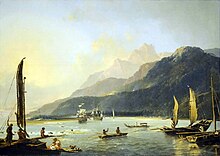
From 1772 to 1775, on the ships HMS Resolution and HMS Adventure , commissioned by the British government with advice from the Royal Society, he went to circumnavigate the globe as far south as possible to finally determine whether there was any great Terra Australis. On 17 January 1773, Resolution was the first ship to venture south of the Antarctic Circle, which she did twice more on this voyage. The final such crossing, on 3 February 1774, was to be the most southerly penetration, reaching latitude 71°10′ S at longitude 106°54′ W. Cook almost encountered the mainland of Antarctica, but turned towards Tahiti to resupply his ship. He then resumed his southward course in a second fruitless attempt to find the supposed continent. On this leg of the voyage, he brought a young Tahitian named Omai, who proved to be somewhat less knowledgeable about the Pacific than Tupaia had been on the first voyage. On his return voyage to New Zealand in 1774, Cook landed at the Friendly Islands , Easter Island , Norfolk Island , New Caledonia , and Vanuatu . Before returning to England, Cook made a final sweep across the South Atlantic from Cape Horn and surveyed, mapped, and took possession for Britain of South Georgia , which had been explored by the English merchant Anthony de la Roché in 1675. Cook also discovered and named Clerke Rocks and the South Sandwich Islands ("Sandwich Land"). He then turned north to South Africa , and from there continued back to England. His reports upon his return home put to rest the popular myth of Terra Australis. Cook's second voyage marked a successful employment of Larcum Kendall's K1 copy of John Harrison's H4 marine chronometer, which enabled Cook to calculate his longitude with much greater accuracy. Cook's log was full of praise for this chronometer, which he used to make charts of the southern Pacific Ocean that were so remarkably accurate that copies of them were still in use in the mid-20th century.

Third Voyage
His third and final voyage (12 July 1776 – 4 October 1780)'s ostensible purpose was to return his second voyage's young Tahitian passenger Omai to his homeland, but this was but a cover for the Admiralty's plan to send Cook on a voyage to discover the Northwest Passage. HMS Resolution , to be commanded by Cook, and HMS Discovery , commanded by Charles Clerke, were prepared for the voyage which started from Plymouth in 1776. After dropping Omai at Tahiti, Cook travelled north and in 1778 became the first European to begin formal contact with the Hawaiian Islands, making landfall in January 1778 at Waimea harbour and Kauai afterwards. Cook named the archipelago the "Sandwich Islands" after the fourth Earl of Sandwich, the acting First Lord of the Admiralty.
The expedition then sailed west to the Siberian coast, and then southeast, back through the Bering Strait. He made a few other attempts to sail through it, and became increasingly frustrated on this voyage, perhaps suffering from a stomach ailment; it has been speculated that this led to irrational behaviour towards his crew, such as forcing them to eat walrus meat, which they found inedible. From the Bering Strait, the crews went south to Unalaska in the Aleutians, where Cook put in on 2 October to again re-caulk the ship's leaking timbers. They then headed back to the Sandwich Islands. Cook was killed at Kealakekua Bay on 14 February 1779, in a conflict with locals. The expedition returned home, reaching England in October 1780.
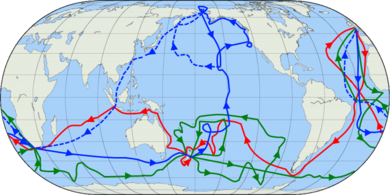
Some ascribe Cook's success to his observation that certain foods — among them lime — prevented scurvy. The term "limey" for an Englishman dates to that era. However, the discovery of the connection between certain foods and the prevention of scurvy was made multiple times by multiple people and forgotten almost as often as discovered. He surely mapped lands and oceans in greater detail and on a scale not previously charted by Western explorers, surveying and naming features, and recorded islands and coastlines on European maps for the first time. He displayed a combination of seamanship, superior surveying and cartographic skills, physical courage, and an ability to lead men in adverse conditions.

There are over 100 memorials to Cook around the world. We only list some of these here, the Captain Cook Society have longer lists .
- HM Bark Endeavour in Whitby is a 40%-sized replica of the Endeavour used by Cook on his first expedition of 1768-71. In summer they potter round the bay for 30 min.

New Zealand
- Look at the change in your pocket, as HM Bark Endeavour is shown on most 50c coins.
- -41.28 174.51 18 Cook Strait . Separating the North and South islands, overland travel between them can be made onboard frequent Cook Strait ferries . The first European to sail here was Abel Tasman, but James Cook established for Europeans that this was a strait enabling ships to sail between the Tasman Sea and the main Pacific Ocean. ( updated Apr 2024 )
- 19.481306 -155.933444 21 Monument to Cook's Death , Kealakekua Bay in Big Island . The attempted kidnapping of Kalaniʻōpuʻu, the ruling chief of the island of Hawaii, to hold him hostage for a stolen lifeboat was the fatal error of Cook's final voyage, and ultimately led to his death. A large white stone monument was commissioned by a local princess on the north shore of the bay in 1874, enclosed by a chain supported by four cannon from the ship HMS Fantome with their breaches embedded in the rock in 1876, and was deeded to the United Kingdom in 1877. It marks the approximate location of Cook's death. The Cook monument is unreachable by road; this remote location is accessible only by water or an hour-long hike along a moderately steep trail. Many visitors have rented kayaks in the town of Captain Cook and paddled across the bay, about 1.5 miles (2.4 km) from its southern end. State conservation regulations prohibit kayaks, stand-up paddleboards, surfboards, and bodyboards from entering the bay unless part of a tour with a licensed local operator. ( updated May 2020 )
- British Empire
- Voyages of George Vancouver
- Voyages of John Franklin
- Voyages of Matthew Flinders
- Articles without Wikipedia links (via Wikidata)
- Has custom banner
- Has map markers
- Guide topics
- Guide articles
- Age of Discovery
- Topic articles
- Has Geo parameter
- Articles with no Wikidata coords
- Pages using the Kartographer extension
Navigation menu
We’re fighting to restore access to 500,000+ books in court this week. Join us!
Internet Archive Audio

- This Just In
- Grateful Dead
- Old Time Radio
- 78 RPMs and Cylinder Recordings
- Audio Books & Poetry
- Computers, Technology and Science
- Music, Arts & Culture
- News & Public Affairs
- Spirituality & Religion
- Radio News Archive

- Flickr Commons
- Occupy Wall Street Flickr
- NASA Images
- Solar System Collection
- Ames Research Center

- All Software
- Old School Emulation
- MS-DOS Games
- Historical Software
- Classic PC Games
- Software Library
- Kodi Archive and Support File
- Vintage Software
- CD-ROM Software
- CD-ROM Software Library
- Software Sites
- Tucows Software Library
- Shareware CD-ROMs
- Software Capsules Compilation
- CD-ROM Images
- ZX Spectrum
- DOOM Level CD

- Smithsonian Libraries
- FEDLINK (US)
- Lincoln Collection
- American Libraries
- Canadian Libraries
- Universal Library
- Project Gutenberg
- Children's Library
- Biodiversity Heritage Library
- Books by Language
- Additional Collections

- Prelinger Archives
- Democracy Now!
- Occupy Wall Street
- TV NSA Clip Library
- Animation & Cartoons
- Arts & Music
- Computers & Technology
- Cultural & Academic Films
- Ephemeral Films
- Sports Videos
- Videogame Videos
- Youth Media
Search the history of over 866 billion web pages on the Internet.
Mobile Apps
- Wayback Machine (iOS)
- Wayback Machine (Android)
Browser Extensions
Archive-it subscription.
- Explore the Collections
- Build Collections
Save Page Now
Capture a web page as it appears now for use as a trusted citation in the future.
Please enter a valid web address
- Donate Donate icon An illustration of a heart shape
The three voyages of Captain James Cook round the world ..
Bookreader item preview, share or embed this item, flag this item for.
- Graphic Violence
- Explicit Sexual Content
- Hate Speech
- Misinformation/Disinformation
- Marketing/Phishing/Advertising
- Misleading/Inaccurate/Missing Metadata
![[WorldCat (this item)] [WorldCat (this item)]](https://archive.org/images/worldcat-small.png)
This book is available with additional data at Biodiversity Heritage Library .
plus-circle Add Review comment Reviews
4,610 Views
19 Favorites
DOWNLOAD OPTIONS
For users with print-disabilities
IN COLLECTIONS
Uploaded by andrew-laskey on June 6, 2008
SIMILAR ITEMS (based on metadata)

IMAGES
VIDEO
COMMENTS
James Cook's three Pacific voyages. James Cook (born October 27, 1728, Marton-in-Cleveland, Yorkshire, England—died February 14, 1779, Kealakekua Bay, Hawaii) was a British naval captain, navigator, and explorer who sailed the seaways and coasts of Canada (1759 and 1763-67) and conducted three expeditions to the Pacific Ocean (1768-71 ...
Captain James Cook FRS (7 November [ O.S. 27 October] 1728 - 14 February 1779) was a British explorer, cartographer and naval officer famous for his three voyages between 1768 and 1779 in the Pacific Ocean and to New Zealand and Australia in particular. He made detailed maps of Newfoundland prior to making three voyages to the Pacific, during ...
The first voyage of James Cook was a combined Royal Navy and Royal Society expedition to the south Pacific Ocean aboard HMS Endeavour, from 1768 to 1771. It was the first of three Pacific voyages of which James Cook was the commander. The aims of this first expedition were to observe the 1769 transit of Venus across the Sun (3-4 June that ...
Captain James Cook Print of James Cook, famous circumnavigator who explored and mapped the Pacific Ocean. The Mariners' Museum 1938.0345.000001 Introduction Captain James Cook is known for his extensive voyages that took him throughout the Pacific. He mapped several island groups in the Pacific that had been previously discovered by other explorers. But he was the first European we know of to ...
The map shows the three voyages of Captain James Cook. The first voyage is in red, the second voyage is in green and the third voyage is in blue. Following Cook's death, the route his crew took is in the blue dashed line. (Credit: Andre Engels) The map shows the three voyages of Captain James Cook.
Enter James Cook, who had just returned from surveying Newfoundland, had recently observed an astronomical event, and who had years of navigational and marine experience; moreover, he was a naval man who had the backing of Philip Stephens, secretary of the Admiralty, who admired Cook's charting work and naval service, and Sir Hugh Palliser, governor of Newfoundland, a longtime Cook mentor ...
James Cook and his voyages. The son of a farm labourer, James Cook (1728-1779) was born at Marton in Yorkshire. In 1747 he was apprenticed to James Walker, a shipowner and master mariner of Whitby, and for several years sailed in colliers in the North Sea, English Channel, Irish Sea and Baltic Sea. In 1755 he volunteered for service in the ...
Captain James Cook's voyages of discovery. Captain James Cook (1728-1779) was born in Yorkshire. At the age of about 17, Cook joined the merchant navy in the coastal town of Whitby and spent his apprenticeship and early career working on trading ships along the English coast and in the Baltic. After 10 years in the merchant navy, Cook entered ...
First Voyage of Captain James Cook. (1768 - 1771) James Cook's first voyage circumnavigated the globe in the ship Endeavour, giving the botanists Joseph Banks and Daniel Solander the opportunity to collect plants from previously unexplored habitats. Although the Endeavour voyage was officially a journey to Tahiti to observe the 1769 transit ...
Book: Cook, James. A Voyage to the Pacific Ocean. Undertaken, by the Command of His Majesty, for Making Discoveries in the Northern Hemisphere, to Determine the Position and Extent of the West Side of North America; Its Distance from Asia; and the Practicability of a Northern Passage to Europe. Performed under the Direction of Captains Cook ...
As captain on three voyages of discovery in the late eighteenth century, James Cook became the first European to define the outline of New Zealand. Thanks to Cook's detailed charts, and his gentlemen passengers' scientific and artistic documentation, accurate knowledge of New Zealand was available in Europe for the first time from the 1770s.
LibriVox recording of The Third Voyage of James Cook, Volume 1 by James Cook. Read in English by David Cole. Only months after his return from his mammoth Second Voyage, the Admiralty ordered Cook back to the Pacific, ostensibly to return Omai, a young man from Raiatea, to his homeland, but in fact to attempt the discovery of the Northwest Passage (a proposed route from the Pacific to the ...
British navigator James Cook charted New Zealand and Australia's Great Barrier Reef on his ship HMB Endeavour and later disproved the existence of the fabled southern continent Terra Australis.
Captain James Cook timeline Follow the key events in Captain Cook's life of adventure from a simple start to global fame and a grisly death.
Third voyage of James Cook. The route of Cook's third voyage shown in red; blue shows the return route after his death. James Cook 's third and final voyage (12 July 1776 - 4 October 1780) took the route from Plymouth via Tenerife and Cape Town to New Zealand and the Hawaiian Islands, and along the North American coast to the Bering Strait .
Two ships were secured, the Resolution for Captain Cook and the Adventure for Captain Tobias Furneaux (1735-1781), who had served under Wallis. Cook, James. A Voyage Towards the South Pole and Round the World: Performed in His Majesty's Ships the Resolution and Adventure, in the Years 1772, 1773, 1774 and 1775. 1st ed. 2 vols. London, 1777.
A British explorer and navigator, Captain James Cook led three expeditions to the Pacific Ocean. His voyages took him south to the Antarctic Circle and north to the Bering…
Explore the fascinating adventures of Captain James Cook, the renowned British explorer and navigator, in this free online book. The voyages of Captain James Cook contains two volumes of his journals, maps, illustrations, and historical context. Learn about his discoveries, encounters, and challenges in the Pacific Ocean and beyond.
Between 1768 and 1779, British Captain James Cook undertook three historic voyages in the Pacific before he was killed in Hawaii.
Voyages of James Cook. Captain James Cook was a British explorer, navigator, cartographer, and captain in the Royal Navy. Sailing both eastwards and westwards around the world, Cook and his crews explored parts of the world no European had sailed before, and like Magellan 258 years earlier, his life ended in a battle on the shores of the Pacific.
Cook, James, 1728-1779, Great Britain. Royal Navy, Voyages around the world, Oceania -- Discovery and exploration, Pacific Coast (South America) -- Description and travel Publisher